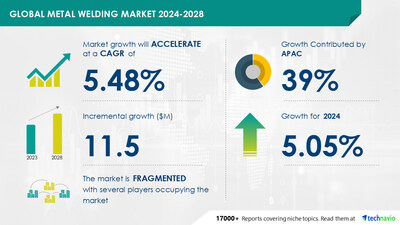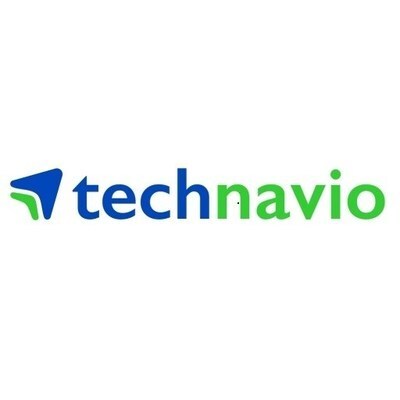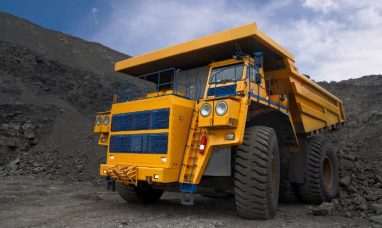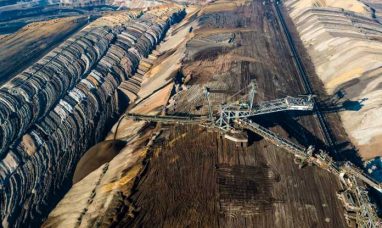NEW YORK, June 7, 2024 /PRNewswire/ — The global metal welding market size is estimated to grow by USD 11.5 million from 2024-2028, according to Technavio. The market is estimated to grow at a CAGR of over 5.48% during the forecast period. Emergence of friction stir welding technology in automotive sector is driving market growth, with a trend towards increased adoption of automated products. However, shortage of skilled workforce poses a challenge. Key market players include Air Liquide SA, AMADA Co. Ltd., Atlas Copco AB, Bystronic Laser AG, DRAHTWERK ELISENTAL W. Erdmann GmbH, EWM AG, Gedik Welding Inc., Hermann Fliess and Co. GmbH, Hilarius Haarlem Holland BV, Hypertherm Inc., Illinois Tool Works Inc., Matsu Manufacturing Inc., Mayville Engineering Co. Inc., Novametal SA, Otter Tail Corp., Safra Spa, The Lincoln Electric Co., voestalpine AG, Vulcan Steel Ltd., and Welding Alloys Group.
Get a detailed analysis on regions, market segments, customer landscape, and companies – View the snapshot of this report
|
Forecast period |
2024-2028 |
|
Base Year |
2023 |
|
Historic Data |
2018 – 2022 |
|
Segment Covered |
Type (Arc, Resistance, Oxyacetylene gas, Solid state, and Others), End-user (Automotive, Construction, Aerospace, and Others), and Geography (APAC, North America, Europe, South America, and Middle East and Africa) |
|
Region Covered |
APAC, North America, Europe, South America, and Middle East and Africa |
|
Key companies profiled |
Air Liquide SA, AMADA Co. Ltd., Atlas Copco AB, Bystronic Laser AG, DRAHTWERK ELISENTAL W. Erdmann GmbH, EWM AG, Gedik Welding Inc., Hermann Fliess and Co. GmbH, Hilarius Haarlem Holland BV, Hypertherm Inc., Illinois Tool Works Inc., Matsu Manufacturing Inc., Mayville Engineering Co. Inc., Novametal SA, Otter Tail Corp., Safra Spa, The Lincoln Electric Co., voestalpine AG, Vulcan Steel Ltd., and Welding Alloys Group |
Key Market Trends Fueling Growth
The metal welding market is experiencing significant growth due to intense competition and the need for product differentiation. Vendors are investing in automated equipment for welding and fabrication to expand their offerings and produce precise parts efficiently.
Automation reduces material costs, enables rapid production, and allows for design flexibility. The demand for fabricated machine parts is driving this trend, leading to increased capital expenditure and higher production efficiency for end-users.
The marketing industry for metal welding is experiencing significant growth. Key players in this sector include manufacturers and suppliers of welding equipment, consumables, and related services. Recent trends indicate an increase in demand for automated and robotic welding systems due to their efficiency and precision.
Additionally, the use of advanced materials like composites and alloys is gaining popularity in various industries such as automotive, construction, and energy. Furthermore, the adoption of digital technologies like IoT and AI in welding processes is transforming the industry, enabling real-time monitoring and predictive maintenance. Overall, the metal welding market is expected to continue its upward trend in the coming years.
Research report provides comprehensive data on impact of trend. For more details- Download a Sample Report
Market Challenges
- The global metal welding market faces challenges due to a shortage of skilled workers in developed markets like the US, Europe, and Australia. Complex machinery operation requires technical knowledge, and unskilled workers can lead to failed welds, increased labor costs, and longer production cycles.
- New welding techniques and equipment demand continuous skill updates, which can be costly and time-consuming. This shortage affects market growth, as companies may need to invest in training or outsource work, limiting their ability to take on larger projects.
- The robotics and automation market, particularly in welding, is experiencing significant growth. With advances in technology, processes like laser and robotic welding have become more common. However, challenges persist. Costs for implementing these technologies can be high. Additionally, the need for skilled labor to operate and maintain these systems remains a concern.
- Furthermore, the use of new materials like oxides and alloys in welding processes adds complexity. Procurement of these materials can be difficult and expensive. Electronics and sensors are also essential components in modern welding systems, adding to the overall cost. Despite these challenges, the market for welding automation continues to expand, driven by the need for increased efficiency and productivity.
For more insights on driver and challenges – Download a Sample Report
Segment Overview
- Type
- 1.1 Arc
- 1.2 Resistance
- 1.3 Oxyacetylene gas
- 1.4 Solid state
- 1.5 Others
- End-user
- 2.1 Automotive
- 2.2 Construction
- 2.3 Aerospace
- 2.4 Others
- Geography
- 3.1 APAC
- 3.2 North America
- 3.3 Europe
- 3.4 South America
- 3.5 Middle East and Africa
1.1 Arc- The arc metal welding market experiences growth due to the widespread use of this joining technique across various industries. Arc welding processes like Flux Core Arc Welding (FCAW), Gas Metal Arc Welding (GMAW), Gas Tungsten Arc Welding (GTAW), Shielded Metal Arc Welding (SMAW), and Submerged Arc Welding (SAW) are commonly employed. However, GMAW presents challenges when welding aluminum alloys, which have low melting points and high thermal conductivity, leading to potential burn-through.
Using aluminum welding wires in GMAW also poses issues due to their softness and low column strength, which can cause tangling. To mitigate these challenges, appropriate welding equipment selection is crucial. Despite these complexities, arc metal welding remains a vital process in automotive, aerospace, oil and gas, power, and construction sectors.
For more information on market segmentation with geographical analysis including forecast (2024-2028) and historic data (2018 – 2022) – Download a Sample Report
Research Analysis
The Metal Welding Market encompasses the welding industry and the fabrication industry, serving the heavy engineering industry, construction activities, and manufacturing operations worldwide. In the context of global population growth and industrial manufacturing operations, the market for welding equipment, including robotic welding and robotic laser welding, has gained significant traction. The market’s expansion is driven by the increasing usage of welding technology in various sectors, such as the defense sector for naval ships, patrol vehicles, and submarines, and the global transportation sector.
Market growth is also influenced by factors like electrification and cash liquidity. Despite nationwide lockdowns and the halt of non-essential manufacturing operations, the market is expected to recover, with market players focusing on low revenue-generating regions to expand their footprint. The welding industry’s market growth stage is characterized by continuous innovation, with robotic welding and electrification being key trends.
Market Research Overview
The global Metal Welding Market is experiencing significant growth due to the increasing demand for metal products in various industries such as automotive, construction, and energy. The market is driven by factors including technological advancements, increasing infrastructure development, and rising industrialization. The market offers various welding processes including Arc Welding, Gas Tungsten Arc Welding (GTAW), and Flux-Cored Arc Welding (FCAW).
These processes are used to join different metals such as steel, aluminum, and stainless steel. The market is also witnessing the emergence of new technologies like Laser Beam Welding and Electron Beam Welding, which offer higher precision and productivity. The market is expected to continue its growth trajectory in the coming years due to the increasing demand for metal products and the ongoing industrialization trend.
Table of Contents:
1 Executive Summary
2 Market Landscape
3 Market Sizing
4 Historic Market Size
5 Five Forces Analysis
6 Market Segmentation
- Type
- Arc
- Resistance
- Oxyacetylene Gas
- Solid State
- Others
- End-user
- Automotive
- Construction
- Aerospace
- Others
- Geography
- APAC
- North America
- Europe
- South America
- Middle East And Africa
7 Customer Landscape
8 Geographic Landscape
9 Drivers, Challenges, and Trends
10 Company Landscape
11 Company Analysis
12 Appendix
About Technavio
Technavio is a leading global technology research and advisory company. Their research and analysis focuses on emerging market trends and provides actionable insights to help businesses identify market opportunities and develop effective strategies to optimize their market positions.
With over 500 specialized analysts, Technavio’s report library consists of more than 17,000 reports and counting, covering 800 technologies, spanning across 50 countries. Their client base consists of enterprises of all sizes, including more than 100 Fortune 500 companies. This growing client base relies on Technavio’s comprehensive coverage, extensive research, and actionable market insights to identify opportunities in existing and potential markets and assess their competitive positions within changing market scenarios.
Contacts
Technavio Research
Jesse Maida
Media & Marketing Executive
US: +1 844 364 1100
UK: +44 203 893 3200
Email: media@technavio.com
Website: www.technavio.com/
![]() View original content to download multimedia:https://www.prnewswire.com/news-releases/metal-welding-market-size-is-set-to-grow-by-usd-11-5-million-from-2024-2028–emergence-of-friction-stir-welding-technology-in-automotive-sector-to-boost-the-market-growth-technavio-302166546.html
View original content to download multimedia:https://www.prnewswire.com/news-releases/metal-welding-market-size-is-set-to-grow-by-usd-11-5-million-from-2024-2028–emergence-of-friction-stir-welding-technology-in-automotive-sector-to-boost-the-market-growth-technavio-302166546.html
SOURCE Technavio

Featured image: DepositPhotos © yayimages










